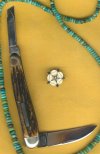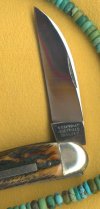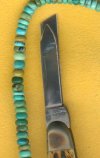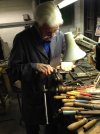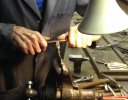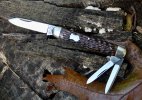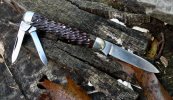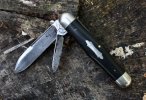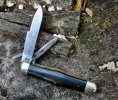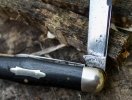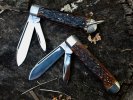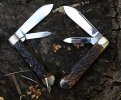"{quote}It's very possible that they were done by someone afterward. I've never seen an absolute mint knife with those marks. You can see that the stag is actually below the liner edge on a couple of the pruners yet the marks are still there. It's definitely a bit of a mystery to me. @ea42{end quote}
Here is that "filed Stag" knife, Eric, open!! Very little use if any, just rub marks! (The plot thickens!!


)
Charlie it certainly does! Geez that's a gorgeous knife! I also note how the cuts are all dark, as if they were hit with compound or PM afterward. It's very puzzling for sure. Maybe it was a common way of roughly trimming the wilder pieces of stag that couldn't be fitted perfectly. We may never know.
Sure would be nice if these old timers were still around, I'll bet they'd have some answers:
“Billy” Morehouse, age 77, bent and infirm, was a “groinder” at the old American Knife Company, Reynolds Bridge, Thomaston, and his father before him was a “groinder” who left Sheffield, England, like many of his [kind?], midway in nineteenth century, to ply his trade in busy New England, Morehouse pere came to Lakeville, Conn., where in years gone by there was a thriving knife business, moved to Winsted, thence to Northfield and Thomaston, like others of the peripatetic craft, returned once to the old country on a “visit” which lasted three years, but came back to Connecticut where he was eventually killed as the result of an accident peculiar to his calling.
“Billy”, feeble, “hard of hearing” but mentally keen still lives in the house his father built high on a hilltop overlooking the Watertown Thomaston road at the western end of the “village.” He switches off his favorite rade program—the National league [game?] broadcast from Boston this afternoon—to answer questions about his vanished trade, first bringing out for inspection a ferocious appearing hunting knife with a blade eight inches long and solid bone handle, and a [combina?]-knife fork and spoon made for the Grand Army of the Republic in wholesale [lots?]. These, he declares, are the only mementoes he possesses of years spent as a knifemaker.
“Made the huntin' knife myself,” he says, “fifty years ago. Look at it. Just as keen and shining as it was the day I finished it. And this other thing here— “ Mr. Morehouse, by deft manipulation, converts the army knife into knife and fork—two pieces where one had been before. Another sleight of hand performance results in the appearance of a spoon, small but serviceable, Folded, the implement appears to be an ordinary, if old fashioned, wooden jack knife, gives no hint of its surprising utility.
“I just kind of drifted into the business,” says Mr. Morehouse. Traces of
the broad Sheffield dialect, refined in these second generation knifemakers, are barely perceptibly in his speech, consist mainly of dropped aitches.
“In the old days, you know, you followed in your father's footsteps as a rule, and that's what I did. That was especially true of knifemakers. My father was a ‘groinder’, and so I became a ‘groinder’.
Learned my trade from 'im. Pierpont and Morse ran the company then—that's the old shop in the village I mean. There was the Thomaston Knife Company up on the main road. I worked there for a while, too, when Warner ran it. Then I left knifemakin' one time and went to work in the watch shop.
“They' 'ad a strike down were 'ere in ninety two. The grinders and the finishers struck. That was when Dr. Feguson owned the place. They tried substitute workmen, but of course some of them didn't know what they were doin' and spoiled a lot of work, so the doctor got tired of it and sold out to a firm in Newark, New Jersy. Then I went to work for Warner. I worked up in Northfield for a while, too.
“The shop in the village 'ere burnt down twice the same year, did Dunbar tell you that when you saw him? I think it was in seventy six. Burnt down once and they rebuilt it and eleven months later it burnt down again.
“My father? Oh, it's kind of a long story. He came 'ere from the old country and went to work up at the Holly Manufacturing Company in Lakeville. Then not long afterwards the Civil War broke out and he enlisted in the Eleventh Connecticut and lost a toe at Fredericksburg. Why'd 'e enlist? Hell, I don't think 'e 'ad any outstandin' reason. He was a militiaman in the old country, he was always [attracted?] to soldierin'.
“I was nine months old when he brought 'is family over 'ere. We lived in Goshen for a while, and then in Northfield. 'E worked up there quite a while before 'e came to the village. 'E was quite a drinker, my father was, like most of the old timers in the trade, and very independent. But 'e was a good worker. It wasn't
anything for him to do three and a half and four dollars a day in the days when two dollars was good pay. But 'e'd go on a spree about once a month and stay out a week or so, so 'e never 'ad any more comin' than the ones that worked steady.
“'E'd be on a [bet?], and run out of money and down 'e'd go to the office and ask them for an advance. If they said no, he'd say, all right by God he wouldn't be back. Then they'd give it to 'em, for 'e was a good worker.
“ 'E finally got killed at 'is work. Up in Winsted it was. A grindstone burst under 'im. It knocked 'im clear to the ceiling, and down the opposity wall, and onto the floor. A piece of the stone hit 'im in the forehead. Well, couple of the men picked 'im up and rushed 'im right to the doctor, and in the meantime 'e come to. At the doctor's 'e bagan to joke about it, and even walked upstairs without 'elp. Wouldn't let them touch 'im. Doctor examined 'im and said 'e seemed to be all right, and 'e went home, and ate 'is supper that night, though 'e didn't eat very much. Followin' day 'e complained of feelin' bad, and soon after 'e was dead. It's my belief 'e 'ad a concussion. They didn't know any too much in those days, the doctors didn't.
“My father wasn't a very tall man, but 'e 'ad a pair of shoulders on 'im like a bull, and 'e was plenty strong. A lot of the grinders would drop off with the con. ‘Groinders' complaint’ they used to call it. It probably would've got me, if I'd worked steadier at it. But I worked in between in the watch shop, you see. I was never as husky as my father, only weight about 127 in the summer and 135 in the wintor. It was very unhealthy work, grindin' was.
“Never 'ad any protection. They used a hankerchief over their noses when they ‘faced’ a stone—that is, trued it up. They were forty two to fifty inches in diameter, the stones were, and had a face about four and a half inches. You'd hang 'em in a trough and true 'em up. Used sharpened steel to true 'em and it made an awful dust. Very unhealthy.
“Used to use English sandstone, mostly, or American bluestone. The sandstone would cut better, but it was apt to break on you. You know 'ow we used to work, sittin' right over the grindstone on a block of oak, with the stone runnin' between the knees and the work in the center. You can see what was likely to 'appen if the stone burst. I 'ad one break on me one time, but as luck would 'ave it I wasn't workin' on it. I was sittin' back readin' a novel at lunch hour, and when they started up at one o'clock I was almost through. I wanted to finish the book,'so I kept on readin'. And damned it my stone didn't go up.
“First thing you 'ad to watch for when you was truin' [em?] was crack or flaws. That's what made 'em break. You might get one almost done and find a flaw in it, and have to start on another. These Lake Huron stones used to give good cuts and some were as [?}]hard as hell's steps,’ they used to say. The Germans, I've heard, worked in front of the stone, some way.
“Well, strikes and fights, and cheap foreign knives were what ruined the grinder's trade. They got strikin' too much around this section, and first thing you know they were doin, the work by machine.
“They struck up in Northfield, I remember. And Catlin went over to England to bring back knifemakers to run his plant, but the Knights of Labor, or some such organizations got to 'em as soon as they landed 'ere and not one of 'em went to work in Northfield. Catlin was liable, under the law, for bringin' those men over 'ere. I think there was a fine of a thousand dollars a head for the offense.
But 'e got Senator Hawley workin' for 'im and 'e got out of it pretty cheap in the end.
“'Owever the boys fixed Senator Hawley for 'is part in it. Next time 'e stood for reelection they sent the senator back 'ome.
“I wish I could give you more details. I'm no good on dates and names. Dunbar's much better at it. He's older than I am, too, over eighty.”




